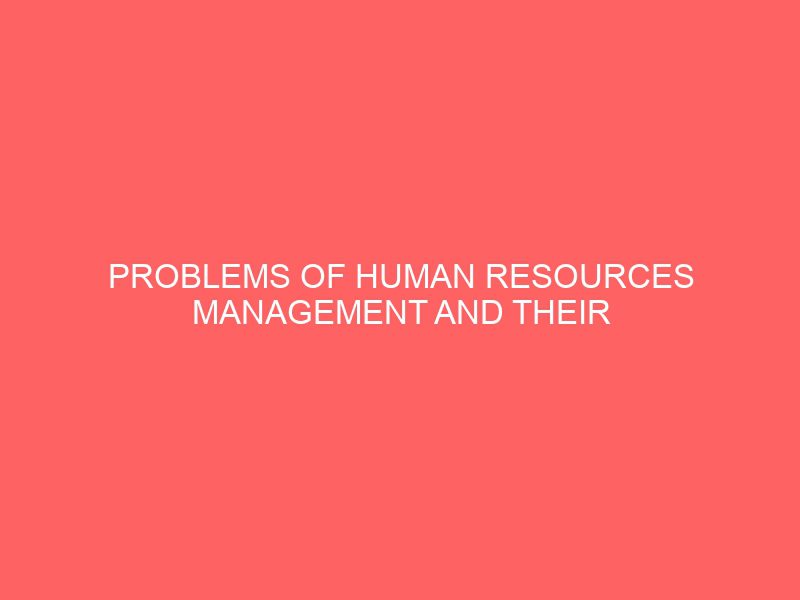Description
ABSTRACT
This project is focused on the problem of Human Resources Management in the Ecobank Nigeria Plc, Asaba. The chapter one of this project work focused on the meaning and function of Human Resources Management also the problem which is human being or the personnel on how to deal with them. What leads to Human Resources Management Problem and their Impact to the Organization today. In order to maximize the economic and social well being of workers. This chapter further highlighted the Ecobank Nigeria Plc profile, the statement of problems, the purpose of the study and the hypotheses with significances. In chapter two, we have the review of literature. The management of organization was introduced and briefed, following with some definitions of Human Resources Management by various theorists and schools of thought, also the Impact of Human Resource Management in an Organizational Performance and Federal Laws affecting human resources management and also the problem of personnel management. The third chapter is all about research methodology. The chapter research, how the questionnaire were designed and method used. The selection of population sample and also the sample size used with the method of data analysis which is chi-square, the decision criteria for validation of hypotheses and the determination of critical value. The fourth chapter is all about the data presentation and analysis. How the questions in the questionnaires were administered and presented with analysis of each question and hypothesis. Finally, chapter five is the summary of findings, recommendations and conclusion made after the research work.
TABLE OF CONTENTS
Cover page i
Title page ii
Declaration iii
Certification iv
Dedication v
Acknowledgements vi
Abstract vii
Table of contents viii
CHAPTER ONE: INTRODUCTION
1.1 Background 1
1.2 General Background 2
1.3 Profile of Ecobank Plc. 5
1.4 Statement of Problems 7
1.5 Purpose of the Study 8
1.6 Research Questions 8
1.7 Statement of Hypotheses 9
1 .8 Significance of the Study 10
1.9 Operationalization of Terms 10
CHAPTER TWO: LITERATURE REVIEW
2.1 Management 12
2.2 Some Definitions of Human Resource Management 13
2.3 Effects of Human Resource Management on Organizational Performance 17
2.4 Management Functions 19
2.5 Operatives Functions 22
2.6 The Role of Human Resources Manager 28
2.7 Leadership and Motivation 28
2.8 Importance of Human Resource Management 30
2.9 Federal Laws Affecting Human Resources 31
2.10 Problems of Human Resources Management 33
CHAPTER THREE: RESEARCH METHODOLOGY
3.1 Introduction 38
3.2 Sources of Data 38
3.3 Population Sample Frame and Size 40
3.4 Instrument of Data Collection 41
3.5 Data Collection Technique 41
3.6 Statistical Tools for Data Analysis 42
3.7 Decision Criteria for Validation of Hypothesis 43
CHAPTER FOUR: PRESENTATION AND ANALYSIS OF DATA
4.1 Introduction 45
4.2 Testing the Hypotheses 49
CHAPTER FIVE: DISCUSSION OF FINDINGS, SUMMARY, CONCLUSION AND RECOMMENDATIONS
5.1 Discussion of Findings 64
5.2 Summary 65
5.3 Conclusion 67
5.4 Recommendation 68
5.5 Areas for Further Findings 69
Bibliography 70
Appendix 71
CHAPTER ONE
1.0 INTRODUCTION
1.1 BACKGROUND
Human Resource Management is not new though misunderstood. Every organization set up so long there are people working thereconscious1y or unconsciously deals with Human Resources management and its attendant problems.
Human Resources Management is dynamic and the source and failure of any organization depends on the human resources. This is because every other resource material, financial and so forth resolves around and indeed controlled by the human resources. There is no gain-saying that the greatest of all resources at the disposal of any organization is the personnel (Human resources). Considering this, the need for effective and efficient human resource management in any organization cannot be overlooked or ignored. This report seek therefore to study or investigate human resources management practices in some Nigeria establishments.
This report research seeks to establish the current personnel management practice, the problems/drawback, prospect and proffer solutions. To effectively achieve this the report is broken down into five (5) chapters for easy understanding







